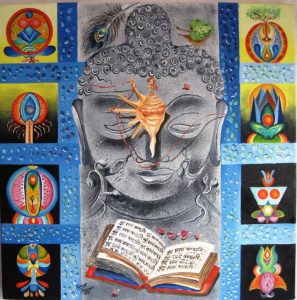 We had the third meeting of our Introduction to Meditation and Mindfulness series at Yoga Bliss today. The course content is adapted from the wonderful work of Insight Meditation teacher, Gil Fronsdal. In our last meeting we focused on mindfulness of the body. We use the breath to stabilize our attention and then we focus the lens of attention on the continuous array of physical sensations. This week we bring in emotion. We experience such a wide range of feeling. We rejoice and despair. With mindfulness we can feel freely and also be free from being driven by emotion. We find freedom in allowing our emotional life to flow.
We had the third meeting of our Introduction to Meditation and Mindfulness series at Yoga Bliss today. The course content is adapted from the wonderful work of Insight Meditation teacher, Gil Fronsdal. In our last meeting we focused on mindfulness of the body. We use the breath to stabilize our attention and then we focus the lens of attention on the continuous array of physical sensations. This week we bring in emotion. We experience such a wide range of feeling. We rejoice and despair. With mindfulness we can feel freely and also be free from being driven by emotion. We find freedom in allowing our emotional life to flow.
Trusting Emotion
 Meditation is a space and time to deeply trust our emotional life. Rather than deny or hold onto an emotion, we can trust this emotional experience can move through us. All emotions are a form of communication. We can listen to what is being communicated when we feel angry. We don’t reactively act on the anger. We have enough trust in the process to open to it more deeply. A transformation of emotion is possible in this opening. We begin to sense the depth of our emotional life and what underlies our everyday busyness.
Meditation is a space and time to deeply trust our emotional life. Rather than deny or hold onto an emotion, we can trust this emotional experience can move through us. All emotions are a form of communication. We can listen to what is being communicated when we feel angry. We don’t reactively act on the anger. We have enough trust in the process to open to it more deeply. A transformation of emotion is possible in this opening. We begin to sense the depth of our emotional life and what underlies our everyday busyness.
It’s very important to distinguish between what happens in life, the difficulties in being human, and the secondary reactions we have to them that add to our suffering. How are we reacting that’s different from just letting a difficulty be there in its simplicity? In mindfulness we don’t judge ourselves negatively for our feelings or reactions. We try to wake up from the trance of our conditioning. We try to pay attention and notice what’s actually going on. It only matters that we wake up. We notice and don’t add anything more.
How do we apply this in mindfulness meditation?
We begin by putting breathing at the center of meditation because focusing on the breath can help concentrate the mind and stabilizing mindfulness. When something else surfaces that becomes more compelling than the breath – like physical sensations – we take our meditative awareness to those sensations. Rather than considering sensations to be a distraction we make them the object of our mindfulness. If emotions become pronounced they become the meditation focus. Emotions can be challenging because we become so easily entangled with them. We either become more involved or resist them. The trick is to have this very simple awareness of the emotion as it’s going through us.
Step by Step
 The first step is the recognition that an emotion has become compelling. Sometimes emotions are strong and urgently call for our attention. At other times, emotions may surface faintly. We may have tendency to dismiss our emotions or fail to appreciate them. Mindfulness involves our recognition that we’re having an emotional experience.
The first step is the recognition that an emotion has become compelling. Sometimes emotions are strong and urgently call for our attention. At other times, emotions may surface faintly. We may have tendency to dismiss our emotions or fail to appreciate them. Mindfulness involves our recognition that we’re having an emotional experience.
The second step is to name the emotion. The power of naming diminishes our tendency to become entangled or identified with an emotion. In a very simple, straightforward way we just name “anger, anger” – “happy, happy” – “sad, sad.” You are naming from a place in your being that isn’t swept away by feeling. That place is safe enough to allow feelings to arise in mindful presence.
The third step involves acceptance or allowance. We allow the emotion to be in awareness freely. In this way our meditation space can be a safe place to allow the full range of emotion – just letting them course through – without having to act on them. We’re giving the feeling permission to be there without outwardly expressing or inwardly suppressing the emotion.
 Once you have the ability to recognize, name and allow the emotion to flow, be curious and start investigating “what is this experience?” How do you experience it in your body – your stomach, jaw or shoulders? Virtually every emotion is expressed in your body. You might feel fear as a tight stomach and raised shoulders. If you’re sad, you might feel fatigue or heaviness. Happiness may present as a softening or tingling, a lightness.
Once you have the ability to recognize, name and allow the emotion to flow, be curious and start investigating “what is this experience?” How do you experience it in your body – your stomach, jaw or shoulders? Virtually every emotion is expressed in your body. You might feel fear as a tight stomach and raised shoulders. If you’re sad, you might feel fatigue or heaviness. Happiness may present as a softening or tingling, a lightness.
You can review the process we did in class at this linked file: Introduction to Meditation Guided Meditation on Mindfulness of Emotions.
Closing Remarks & Homework
Gil Fronsdal describes a practice called “riding out an emotion” or “riding out the desire”. You wait till you have a really strong juicy desire and when that time comes, sit down in a chair, and don’t give in to it, ride it out. All the lawyers of the mind come out and will explain why you have to go do something, and you quiet the lawyers, and then the publicists come out, the commercials come out, and all this tremendous surge of energy, this tremendous compulsion, really powerful, but you’re committed like being at the rodeo, you’re not going to fall off your horse, and sooner or later, its guaranteed, the wave will kind of crest and you’ll find yourself on the other side. And you’ll get calm eventually. When you come out the other side of the wave you might feel more free – even empowered.
Practicing over time can create a shift toward realizing more naturally occurring emotions and away from reactive emotions. The key to making this shift is just staying present in a very simple way. Be fully present to what is to become more intimate with your authentic life. You can find this week’s practice suggestion at this linked file: Introduction to Meditation Mindfulness of Emotions Homework.
Let us remember two primary aims of mindfulness practice:
 One is to take a closer look at the life you are living. Not the life you imagine you are living. The life you are living is always here in your lived experience. You can consider that mindfulness is a kind of intimacy with life.
One is to take a closer look at the life you are living. Not the life you imagine you are living. The life you are living is always here in your lived experience. You can consider that mindfulness is a kind of intimacy with life.
The other primary function is to free ourselves. The nature of simple awareness is liberating. We are usually predisposed to seeing things in certain ways due to our past history or future expectations. Seeing more deeply helps us to liberate our judgments and reactions and see life clearly.
